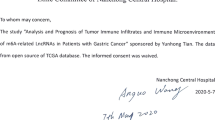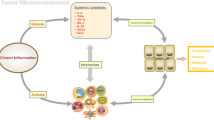Abstract
Background
Long non-coding RNA (lncRNA) T-cell leukemia/lymphoma 6 (TCL6) has been reported as a potential tumor suppressor. However, its expression and function in breast cancer remain unknown. This study was performed to investigate the expression of lncRNA TCL6 in breast cancer and its clinical significance.
Methods
The survival and clinical molecular roles of TCL6 in breast cancer were analyzed. The underlying mechanism modulated by TCL6 and its correlation with immune-infiltrating cells were investigated. Gene Expression Omnibus (GEO) datasets were further used to confirm the prognostic role of TCL6.
Results
TCL6 low expression was not correlated with age, clinical stage, T stage, lymph node metastasis, distant metastasis, human epidermal growth factor 2 status, but was associated with estrogen receptor and progesterone receptor (PR) status and was an independent factor for worse survival (HR 1.876, P = 0.016). Specifically, low TCL6 expression correlated with worse prognosis in PR-negative patients. TCL6 could predict worse survival in luminal B breast cancer based on intrinsic subtypes. Immune-related pathways such as Janus kinase–signal transducer of activators of transcription were regulated by TCL6. Further finding revealed that TCL6 correlated with immune infiltrating cells such as B cells (r = 0.25, P < 0.001), CD8+ T cells (r = 0.23, P < 0.001), CD4+ T cells (r = 0.25, P < 0.001), neutrophils (r = 0.21, P < 0.001), and dendritic cells (r = 0.27, P < 0.001). TCL6 was also positively correlated with tumor-infiltrating lymphocytes infiltration and PD-1, PD-L1, PD-L2, and CTLA-4 immune checkpoint molecules (P < 0.001).
Conclusion
Our findings suggest that lncRNA TCL6 correlates with immune infiltration and may act as a useful prognostic molecular marker in breast cancer.








Similar content being viewed by others
Abbreviations
- TCL6:
-
T-cell leukemia/lymphoma 6
- lncRNA:
-
Long non-coding RNA
- HER-2:
-
Human epidermal growth factor 2
- ER:
-
Estrogen receptor
- PR:
-
Progesterone receptor
- TN:
-
Triple negative
- DC:
-
Dendritic cells
- OS:
-
Overall survival
- TMM:
-
Trimmed mean of M values
- GSEA:
-
Gene set enrichment analysis
- NES:
-
Normalized enrichment score
- FDR:
-
False discovery rate
- TCGA:
-
The Cancer Genome Atlas
- GEO:
-
Gene Expression Omnibus
- TIICs:
-
Tumor-infiltrating immune cells
- TIL:
-
Tumor-infiltrating lymphocytes
- TME:
-
Tumor microenvironment
- VEGF:
-
Vascular endothelial growth factor
- TLR:
-
Toll-like receptor
- JAK/STAT:
-
Janus kinase–signal transducer of activators of transcription
- PD-1:
-
Programmed death 1
- PD-L1:
-
Programmed cell death 1 ligand 1
- PD-L2:
-
Programmed cell death 1 ligand 2
- CTLA-4:
-
Cytotoxic T-lymphocyte-associated antigen 4
References
Bray F, Ferlay J, Soerjomataram I, Siegel RL, Torre LA, Jemal A. Global cancer statistics 2018: GLOBOCAN estimates of incidence and mortality worldwide for 36 cancers in 185 countries. CA Cancer J Clin. 2018;68:394–424.
Biglia N, D'Alonzo M, Sgro LG, Tomasi Cont N, Bounous V, Robba E. Breast cancer treatment in mutation carriers: surgical treatment. Minerva Ginecol. 2016;68:548–56.
Gradishar WJ, Anderson BO, Balassanian R, Blair SL, Burstein HJ, Cyr A, et al. Breast cancer version 2.2015. J Natl Compr Cancer Netw. 2015;13:448–75.
Rakha EA, Reis-Filho JS, Ellis IO. Combinatorial biomarker expression in breast cancer. Breast Cancer Res Treat. 2010;120:293–308.
Payne SJ, Bowen RL, Jones JL, Wells CA. Predictive markers in breast cancer—the present. Histopathology. 2008;52:82–90.
Lin C, Yang L. Long noncoding RNA in cancer: wiring signaling circuitry. Trends Cell Biol. 2018;28:287–301.
Bhan A, Soleimani M, Mandal SS. Long noncoding RNA and cancer: a new paradigm. Cancer Res. 2017;77:3965–81.
Matsui M, Corey DR. Non-coding RNAs as drug targets. Nat Rev Drug Discov. 2017;16:167–79.
Isin M, Dalay N. LncRNAs and neoplasia. Clin Chim Acta. 2015;444:280–8.
Li J, Li Z, Zheng W, Li X, Wang Z, Cui Y, et al. LncRNA-ATB: an indispensable cancer-related long noncoding RNA. Cell Prolif. 2017;50:e12381.
Renganathan A, Felley-Bosco E. Long noncoding rnas in cancer and therapeutic potential. Adv Exp Med Biol. 2017;1008:199–222.
Li X, Li N. LncRNAs on guard. Int Immunopharmacol. 2018;65:60–3.
Yu WD, Wang H, He QF, Xu Y, Wang XC. Long noncoding RNAs in cancer-immunity cycle. J Cell Physiol. 2018;233:6518–23.
Malih S, Saidijam M, Malih N. A brief review on long noncoding RNAs: a new paradigm in breast cancer pathogenesis, diagnosis and therapy. Tumour Biol. 2016;37:1479–85.
Su H, Sun T, Wang H, Shi G, Zhang H, Sun F, et al. Decreased TCL6 expression is associated with poor prognosis in patients with clear cell renal cell carcinoma. Oncotarget. 2017;8:5789–99.
Bertucci F, Chaffanet M, Birnbaum D. An ICGC major achievement in breast cancer: a comprehensive catalog of mutations and mutational signatures. Chin Clin Oncol. 2017;6:4.
Alexandrov LB, Nik-Zainal S, Wedge DC, Aparicio SA, Behjati S, Biankin AV, et al. Signatures of mutational processes in human cancer. Nature. 2013;500:415–21.
Subramanian A, Tamayo P, Mootha VK, Mukherjee S, Ebert BL, Gillette MA, et al. Gene set enrichment analysis: a knowledge-based approach for interpreting genome-wide expression profiles. Proc Natl Acad Sci USA. 2005;102:15545–50.
Li T, Fan J, Wang B, Traugh N, Chen Q, Liu JS, et al. TIMER: a web server for comprehensive analysis of tumor-infiltrating immune cells. Cancer Res. 2017;77:e108–10.
Gyorffy B, Lanczky A, Eklund AC, Denkert C, Budczies J, Li Q, et al. An online survival analysis tool to rapidly assess the effect of 22,277 genes on breast cancer prognosis using microarray data of 1,809 patients. Breast Cancer Res Treat. 2010;123:725–31.
Liu Y, Sharma S, Watabe K. Roles of lncRNA in breast cancer. Front Biosci (Sch Ed). 2015;7:94–108.
Bin X, Hongjian Y, Xiping Z, Bo C, Shifeng Y, Binbin T. Research progresses in roles of LncRNA and its relationships with breast cancer. Cancer Cell Int. 2018;18:179.
Saitou M, Sugimoto J, Hatakeyama T, Russo G, Isobe M. Identification of the TCL6 genes within the breakpoint cluster region on chromosome 14q32 in T-cell leukemia. Oncogene. 2000;19:2796–802.
Tao S, Wang W, Liu P, Wang H, Chen W. Long non-coding RNA T-cell leukemia/lymphoma 6 serves as a sponge for miR-21 modulating the cell proliferation of retinoblastoma through PTEN. Korean J Physiol Pharmacol. 2019;23:449–58.
Holliday DL, Speirs V. Choosing the right cell line for breast cancer research. Breast Cancer Res. 2011;13:215.
Perrot-Applanat M, Di Benedetto M. Autocrine functions of VEGF in breast tumor cells: adhesion, survival, migration and invasion. Cell Adhes Migr. 2012;6:547–53.
Gasparini G. Prognostic value of vascular endothelial growth factor in breast cancer. Oncologist. 2000;5(Suppl 1):37–44.
Johnson DE, O'Keefe RA, Grandis JR. Targeting the IL-6/JAK/STAT3 signalling axis in cancer. Nat Rev Clin Oncol. 2018;15:234–48.
Groner B, von Manstein V. Jak Stat signaling and cancer: opportunities, benefits and side effects of targeted inhibition. Mol Cell Endocrinol. 2017;451:1–14.
Zhang C, Ben A, Reville J, Calabrese V, Villa NN, Bandyopadhyay M, et al. Immunotherapeutic impact of toll-like receptor agonists in breast cancer. Anticancer Agents Med Chem. 2015;15:1134–40.
Wang P, Xue Y, Han Y, Lin L, Wu C, Xu S, et al. The STAT3-binding long noncoding RNA lnc-DC controls human dendritic cell differentiation. Science. 2014;344:310–3.
Kan JY, Wu DC, Yu FJ, Wu CY, Ho YW, Chiu YJ, et al. Chemokine (C–C motif) ligand 5 is involved in tumor-associated dendritic cell-mediated colon cancer progression through non-coding RNA MALAT-1. J Cell Physiol. 2015;230:1883–944.
Doi T, Ishikawa T, Okayama T, Oka K, Mizushima K, Yasuda T, et al. The JAK/STAT pathway is involved in the upregulation of PD-L1 expression in pancreatic cancer cell lines. Oncol Rep. 2017;37:1545–54.
Saleh R, Toor SM, Khalaf S, Elkord E. Breast cancer cells and PD-1/PD-L1 blockade upregulate the expression of PD-1, CTLA-4, TIM-3 and LAG-3 immune checkpoints in CD4(+) T cells. Vaccines (Basel). 2019;7:149.
Goltz D, Gevensleben H, Vogt TJ, Dietrich J, Golletz C, Bootz F, et al. CTLA4 methylation predicts response to anti-PD-1 and anti-CTLA-4 immunotherapy in melanoma patients. JCI Insight. 2018;3:96793.
Acknowledgements
We gratefully acknowledge The Cancer Genome Atlas and Gene Expression Omnibus.
Funding
This study was funded by the Zhejiang Medical and Health Science and Technology Plan Project (Grant number: 2015KYB432).
Author information
Authors and Affiliations
Contributions
YZ, ZL, and BL contributed to the conception and design of this research. YZ, ZL, HC, MC, QZ, LL, and BL contributed to the drafting of the article and final approval of the submitted version. YZ, ZL, HC, MC, QZ, LL, and BL contributed to data analyses and the interpretation and completion of the figures and tables. All authors read and approved the final manuscript.
Corresponding authors
Ethics declarations
Conflict of interest
The authors declare that they have no conflicts of interest.
Ethical approval
All procedures performed in studies involving human participants were in accordance with the ethical standards of The Cancer Genome Atlas Human Subjects Protection and Data Access Policies, adopted by the National Cancer Institute (NCI) and the National Human Genome Research Institute (NHGRI).
Informed consent
Informed consent was obtained from all individual participants included in the study.
Additional information
Publisher's Note
Springer Nature remains neutral with regard to jurisdictional claims in published maps and institutional affiliations.
Electronic supplementary material
Below is the link to the electronic supplementary material.
About this article
Cite this article
Zhang, Y., Li, Z., Chen, M. et al. lncRNA TCL6 correlates with immune cell infiltration and indicates worse survival in breast cancer. Breast Cancer 27, 573–585 (2020). https://doi.org/10.1007/s12282-020-01048-5
Received:
Accepted:
Published:
Issue Date:
DOI: https://doi.org/10.1007/s12282-020-01048-5




